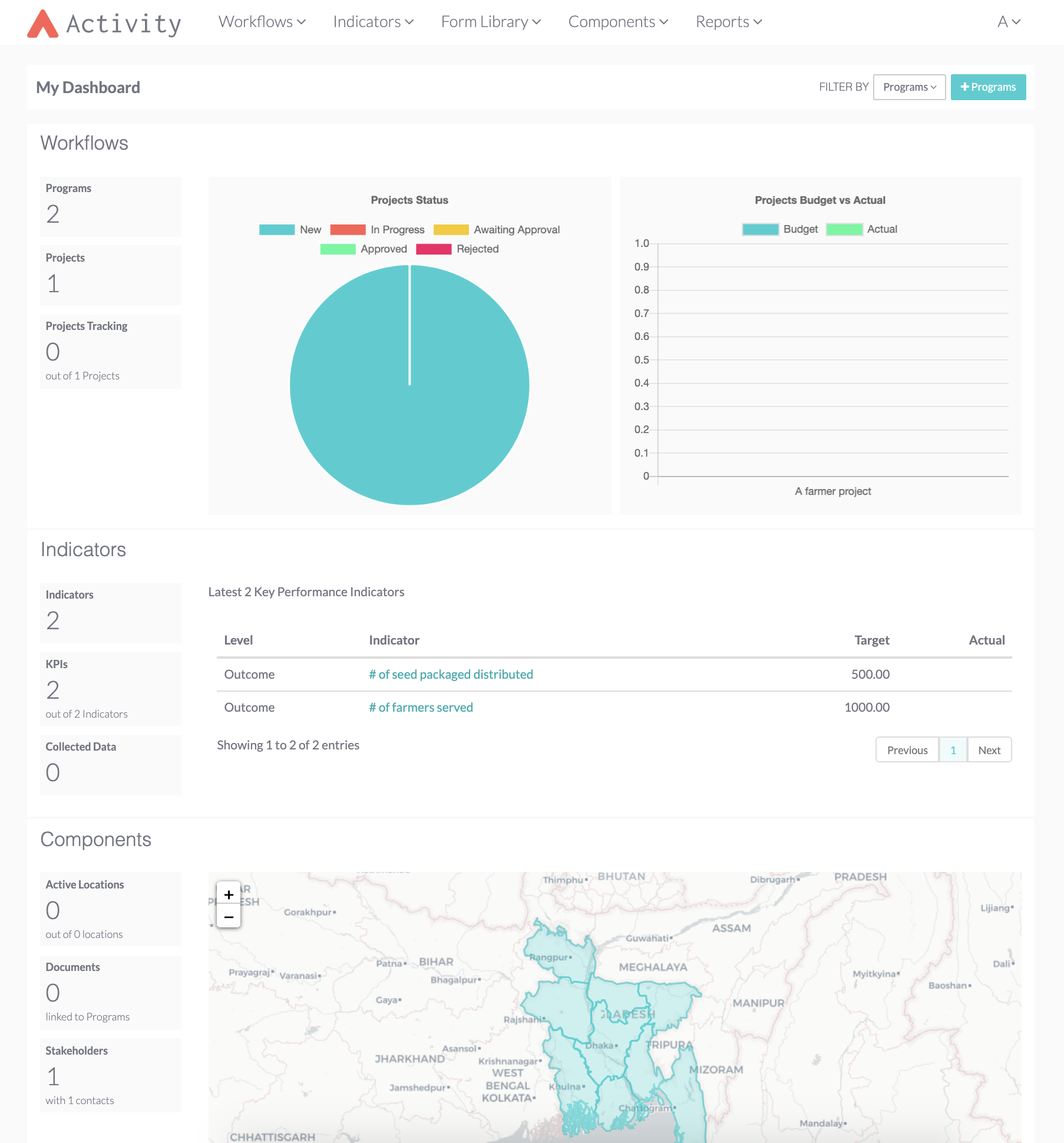A modern way for nonprofits to manage project activities and indicator results.
Try out Activity using our hosted version at hikaya.io.

This is the source code that runs the Activity application. If you want to use Activity then you don't need to run this code, we offer a hosted version of the app at activity.hikaya.app.
If you'd like to run your own copy of Activity or contribute to its development, then this is the place for you.
- Git
- Docker
- Python 3.7+, preferably inside a Python virtual environment (virtualenv, pipenv or others)
- Make sure your dependencies are up-to-date. Update depdendencies with
sudo apt-get update && sudo apt-get -y upgrade # Linux
brew update && brew upgrade # MacFor the sake of similarity between developers environments and the deployment environments, we strongly recommend using Docker. For more details, see the Docker installation guide.
git clone --branch develop https://github.com/hikaya-io/activity.git && cd activitycp settings/local-sample.py settings/local.pydocker compose up -dThis will:
- Pull needed Docker images
- Launch PostgreSQL
- Build and launch Activity
- Run database migrations on the PostgreSQL instance
It may take a while, but Activity should be accessible at https://localhost:8080
This setup is using the environment variables defined in the file .env.docker-compose.
You can read more about Activity's expected environments variables in our installation guide.
-
Apply the Django fixtures defined in the
fixturesfolder:docker compose exec app python manage.py loaddata fixtures/auth_groups.json # Add authorization groups docker compose exec app python manage.py loaddata fixtures/countries.json # Add countries docker compose exec app python manage.py loaddata fixtures/sectors.json # Add sectors
-
Create a Django superuser/admin
docker compose exec app python manage.py createsuperuserYou can now use it to login at https://localhost:8000/admin
-
Signup with a new user on Activity. Activate it through Django Admin Dashboard on
https://localhost:8000/admin/workflow/activityuser/
You can now set up your favourite reverse proxy and link a domain to expose the app to the public.
You can use any cloud hosting provider of your choice. We have used Digital Ocean and used App services to easily deploy the app. Here is the setup documentmention on Digital Ocean for Django app. The Digital Ocean Basic plan of 512 MB RAM | 1 vCPU will suffice. Possible option for database config for the app: 1 GB RAM / 1vCPU / 10 GB Disk / Primary only / PostgreSQL 15.
If you want setup from a droplet here are the steps you can follow to set up deployment and hosting:
-
Create an account on Digital Ocean.
-
Create a droplet. You can select a the Basic Ubuntu plan with at least 4GB RAM as Docker requires at least 4GB RAM droplet. RAM requirement can potentially be reduced by using Dockerhub.
-
Add your SSH key as you create your droplet. This is required to access the server later.
-
Once the droplet is created add your domain and DNS information.
-
Now your droplet is ready for adding your project data. On your local machine
cdinto the root project folder and copy files over to the serverrsync -av -e "ssh -i $LINK/TO/SSH_KEY/FILE/DIRECTORY" PROJECT_FOLDER_NAME [email protected]:/root
-
SSH into your server to check if the files are copied correctly
ssh -i $LINK/TO/SSH_KEY/FILE/DIRECTORY [email protected]
-
In your server, install docker. Here are the setup instructions for Ubuntu
-
Copy the settings files
cp settings/local-sample.py settings/local.py
-
Then build and run the project on docker
docker compose up -d
-
You can check if containers are built correctly and running by running
docker contain ls -a
-
Run through the 'post-installation' steps from the above section to make sure all the fixtures are in place.
-
Make sure to add the environment variables on Digital Ocean.
-
Your application should be ready and accessible on your domain.
Activity is built and maintained by the team at Hikaya.
Feel free to checkout and learn more about:
We are always looking for a fresh set of 👀 who want to contribute to Activity, so if you are interested, you can reach out in our issues board or open a Github discussion and we'll help you get started!